NCERT Summary: Our Solar System - 1 | Geography for UPSC CSE PDF Download
The Solar System
Formation (The Nebula)
- The solar system began as a nebula, a vast cloud of gas and dust in space.
- This nebula started to collapse under its own gravity, leading to the formation of the Sun at its core and the surrounding material that would become the planets.
- This process is believed to have occurred around 5-5.6 billion years ago, with the planets forming later, about 4.6 billion years ago.
The Sun
- The Sun is a large sphere of hot gases, primarily composed of Hydrogen.
- The bright surface of the Sun is known as the Photosphere.
- The outermost layer of the Sun’s atmosphere, which consists of thin and hot gases, is referred to as the Corona.
- The Corona can only be seen during a total solar eclipse.
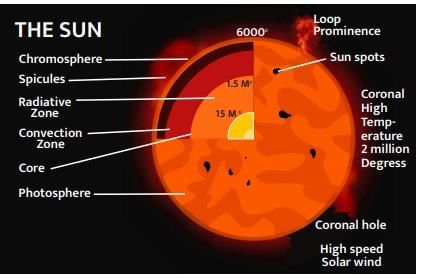
Planets
The solar system is a vast and complex system that includes the Sun and all the celestial bodies that are bound to it by gravity. This includes planets, moons, asteroids, comets, and a variety of smaller objects. Around the sun, there are eight planets (Mercury, Venus, Earth, Mars, Jupiter, Saturn, Uranus, and Neptune), their satellites, asteroids, comets, meteoroids, and interplanetary dust. Pluto, once a part of the Solar System, is now classified as a dwarf planet.
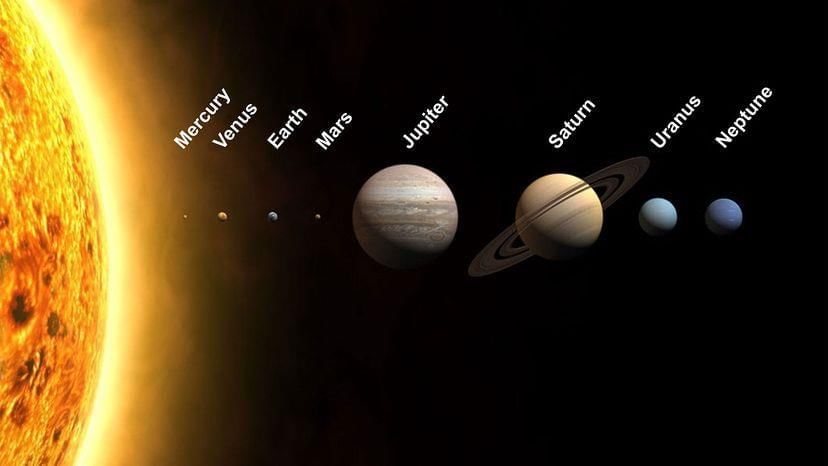
These planets are further categorized into two groups:
Inner Planets: Also known as terrestrial planets, they are composed mainly of rock and metal. They have solid surfaces and are denser than the outer planets. The inner planets are:
- Mercury: The closest planet to the Sun, Mercury has a thin atmosphere and is known for its extreme temperature fluctuations.
- Venus: Often called Earth’s twin due to its similar size, Venus has a thick, toxic atmosphere and is the hottest planet in the solar system.
- Earth: The only planet known to support life, Earth has a diverse range of environments and a protective atmosphere.
- Mars: Known as the Red Planet, Mars has a thin atmosphere and is home to the largest volcano and canyon in the solar system.
Outer Planets: These planets are much larger than the inner planets and are primarily composed of gases. They have thick atmospheres and lack solid surfaces. The outer planets are:
- Jupiter: The largest planet in the solar system, Jupiter is known for its Great Red Spot, a massive storm, and its many moons.
- Saturn: Famous for its stunning rings, Saturn is the second-largest planet and is made mostly of hydrogen and helium.
- Uranus: An ice giant with a unique tilt, Uranus has a blue color due to methane in its atmosphere.
- Neptune: The farthest planet from the Sun, Neptune is known for its deep blue color and strong winds.
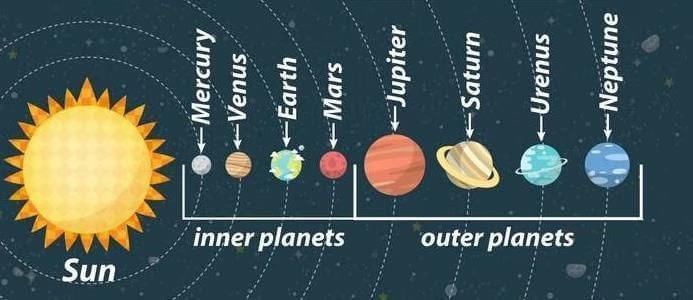
Components
- Asteroids: These are small, rocky bodies that orbit the Sun, primarily found in the asteroid belt between Mars and Jupiter. They vary in size and shape and are remnants from the early solar system.
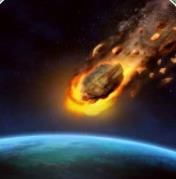
- Comets: Comets are composed of ice, dust, and rocky material. They originate from the outer regions of the solar system and, when they approach the Sun, the heat causes their ice to vaporize, creating a glowing coma and tail.
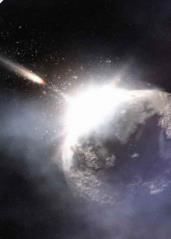 Meteors:
Meteors: - Meteors are small space objects, which can include tiny pieces of comets or fragments of asteroids.
- When these objects enter the Earth's atmosphere, they burn up and create a bright streak of light.
- This bright light is often called a shooting star.
- If a meteor is large enough to survive its journey through the atmosphere and lands on Earth, it is referred to as a meteorite.
- It is interesting to note that the number of meteorites found on the Moon is much higher than those on Earth.
- This is because the Moon does not have an atmosphere to burn up these meteors.

Two Groups of Planets: Terrestrial VS Jovian
Terrestrial Planets (Earth- like)
- Includes Mercury, Venus, Earth, and Mars.
- They have solid, rocky surfaces similar to Earth.
- None of them have rings, though Earth has belts of trapped radiation.
- Only Earth has a strong global magnetic field. Mars and the Moon have localized magnetic fields, but no global field.
- Mercury: Almost no atmosphere; extremely hot surface, but water ice exists in permanently shadowed polar craters.
- Venus: Dense, hot, CO₂-rich atmosphere with permanent clouds, hiding the surface.
- Earth: Supports life with a substantial atmosphere and magnetic field.
- Mars: Thin CO₂ atmosphere, with polar ice caps of water and carbon dioxide.
Jovian Planets (Jupiter-like / Gas Giants)
- Includes Jupiter, Saturn, Uranus, and Neptune.
- Known as gas giants, they are massive and mainly composed of hydrogen and helium, with traces of other gases and ices.
- All have strong magnetic fields, rings, and numerous satellites.
- Jupiter: More massive than all other planets combined; emits electromagnetic energy from charged particles in its strong magnetic field.
- Saturn: Famous for its extensive, complex ring system; visible to the naked eye. Its moon Titan is the second-largest moon in the solar system.
- Uranus and Neptune: Giant gaseous planets with compositions similar to Jupiter’s.
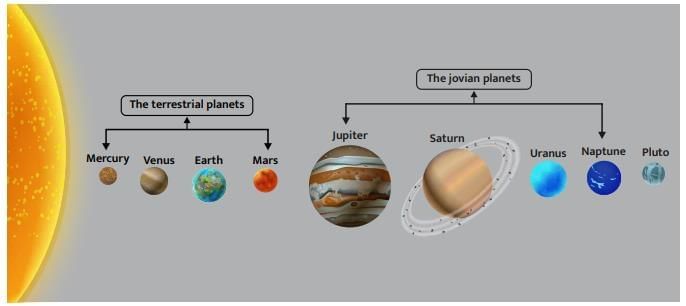
Galilean Moons of Jupiter:
- Io: Most volcanically active body due to tidal heating.
- Europa: Smooth ice shell; likely has a subsurface liquid water ocean.
- Ganymede: Mountains, valleys, craters, cooled lava flows; ancient surface; possible subsurface ocean.
- Callisto: Heavily cratered, outermost moon; surface unchanged since early formation.
The Moon
The moon is the only natural satellite of the earth. Like the origin of the earth, there have been attempts to explain how the moon was formed. In 1838, Sir George Darwin suggested that initially, the earth and the moon formed a single rapidly rotating body. The whole mass became a dumbbell-shaped body and eventually, it broke. It was also suggested that the material forming the moon was separated from what we have at present the depression occupied by the Pacific Ocean.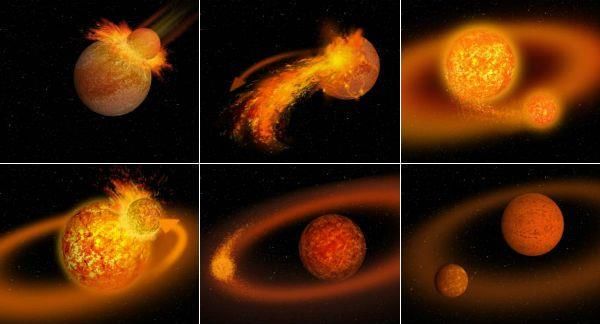
The Big Splat
- Scientists have not reached a consensus on earlier theories regarding the Moon's formation. However, the prevailing view is that the Moon became Earth's satellite due to a "giant impact," often referred to as "the big splat."
- This theory suggests that a body measuring between one and three times the size of Mars collided with the Earth shortly after the planet's formation.
- The force of this collision expelled a substantial portion of the Earth's material into space.
- The ejected debris subsequently entered orbit around the Earth and eventually coalesced to form the Moon, approximately 4.44 billion years ago.
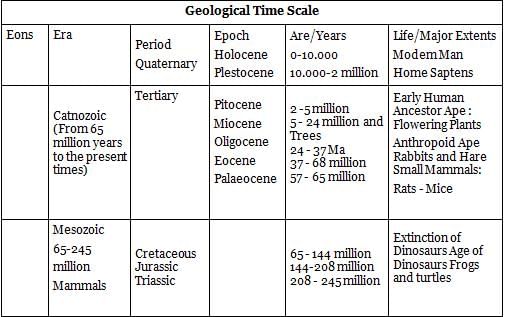
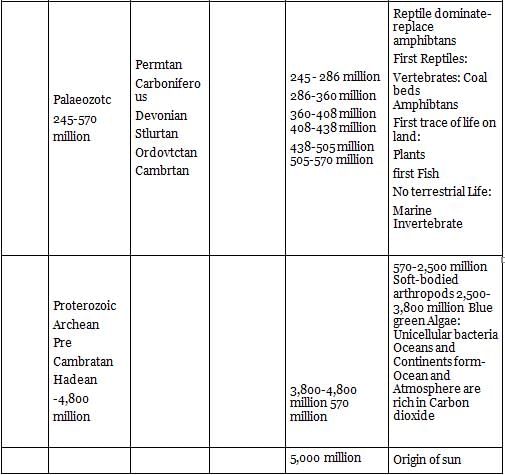
Astronomical Units
Light Year
A light year is a measure of distance and not of time. Light travels at a speed of 3,00,000 km/second. Considering this, the distances the light will travel in one year is taken to be one light year. This equals 9.461x1012 km. The mean distance between the sun and the earth is 149,598,000 km. In terms of light years, it is 8.311 minutes of a year.
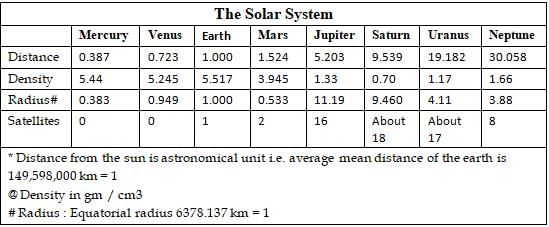
Some Interesting Facts about Solar System
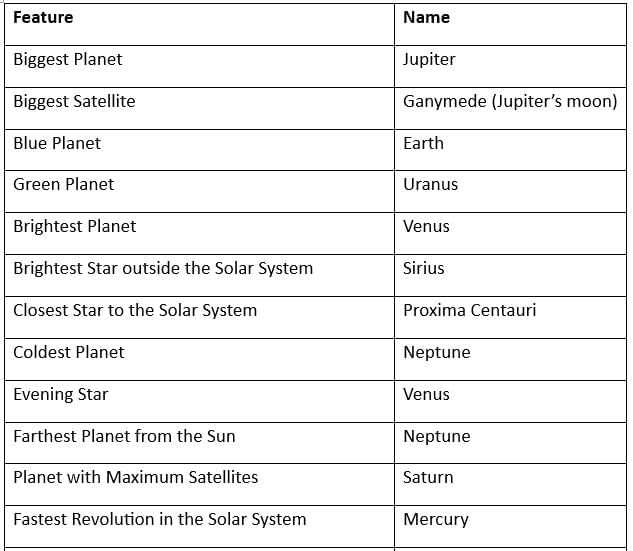
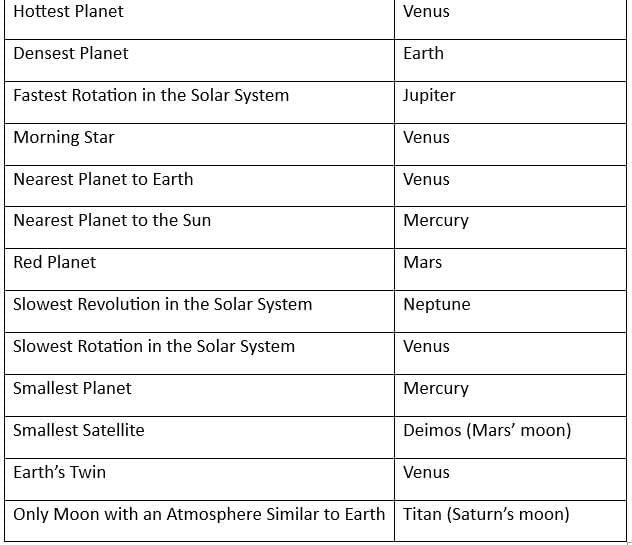
Earth Movements & Phenomena
1. Earth Movements
(a) Rotation
- Definition: Spinning of Earth on its axis (imaginary line joining North & South Pole).
- Duration: 23 hours 56 minutes 4 seconds (~24 hrs).
- Direction: West → East (counterclockwise when viewed from North Pole).
Speed:
At equator: ~1670 km/hr.
Decreases towards poles (zero at poles).
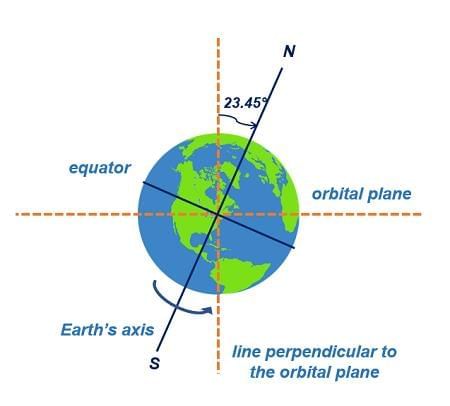
Effects of Rotation:
- Day & Night formation.
- Apparent movement of Sun & stars from east to west.
- Time difference across longitudes (basis for time zones).
- Coriolis effect → deflection of winds & ocean currents.
- Tidal effects → in combination with Moon’s gravity.
- Definition: Earth’s orbital motion around the Sun in an elliptical path.
- Duration: 365 days 6 hours.
- Direction: Counterclockwise (west → east).
- Orbit Shape: Elliptical (perihelion = closest in Jan, aphelion = farthest in July).
- Axis Tilt: 23.5° to orbital plane → main cause of seasons.
Effects of Revolution:
- Seasonal changes (summer, winter, spring, autumn).
- Variation in day length across seasons and latitudes.
- Changes in solar altitude at different times of year.
- Apparent migration of the Sun between Tropic of Cancer & Tropic of Capricorn.
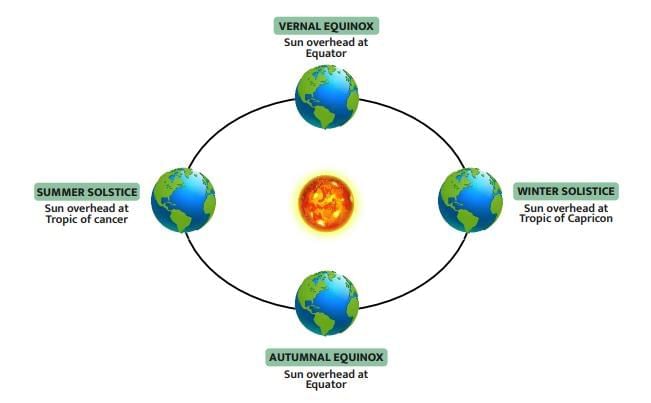
2. Equinoxes & Solstices
Equinoxes:
- Sun vertically overhead at Equator.
- Day & night equal all over Earth (12 hrs each).
- Occurs on 21 March (Vernal) & 23 September (Autumnal).
Solstices:
Sun’s rays vertical either at Tropic of Cancer or Tropic of Capricorn.
21 June (Summer Solstice):
- N. Hemisphere tilted towards Sun.
- Longest day in N. Hemisphere, shortest in S. Hemisphere.
22 December (Winter Solstice):
- S. Hemisphere tilted towards Sun.
- Longest day in S. Hemisphere, shortest in N. Hemisphere.
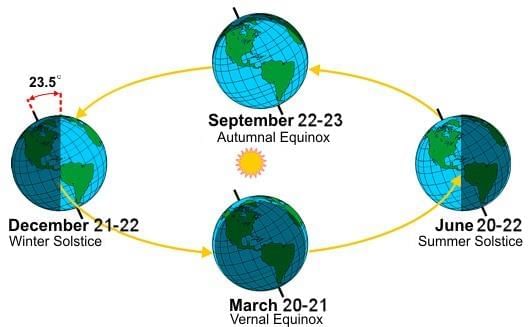
3. Eclipses (Solar, Lunar, Umbra/Penumbra)
(a) Solar Eclipse
- Occurs when Moon comes between Sun & Earth, blocking Sun’s rays.
- Types:
- Total – Moon completely covers Sun (umbra falls on Earth).
- Partial – Only part of Sun obscured (penumbra falls on Earth).
- Annular – Moon appears smaller, leaves ring of Sun visible.
Conditions:
- New Moon phase.
- Moon near ecliptic plane.
(b) Lunar Eclipse
- Occurs when Earth comes between Sun & Moon, Earth’s shadow falls on Moon.
- Types:
- Total – Entire Moon in Earth’s umbra.
- Partial – Only part of Moon in umbra.
- Penumbral – Moon passes through Earth’s penumbra (subtle darkening).
Conditions:
- Full Moon phase.
- Moon near ecliptic plane.
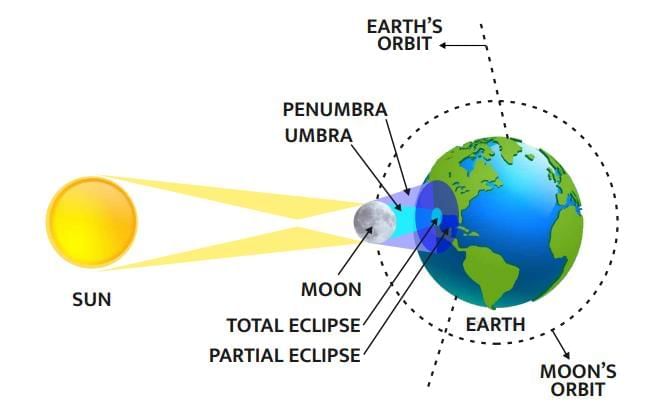
(c) Umbra & Penumbra
- Umbra: Region of total shadow (no sunlight).
- Penumbra: Region of partial shadow (some sunlight).
- Responsible for partial/total nature of eclipses.
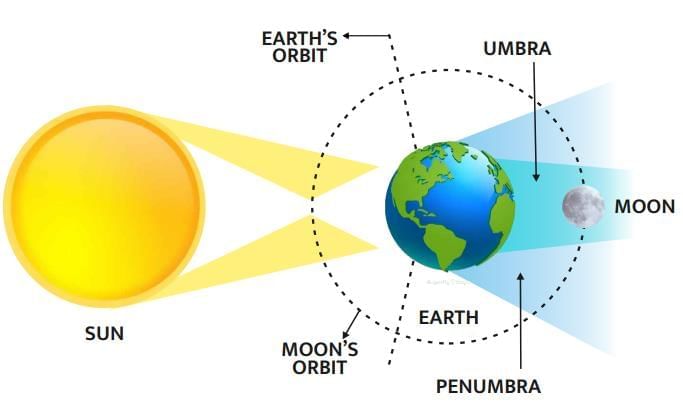
4. Time Zones
- Earth’s Rotation Basis: 360° in 24 hrs → 15° per hour.
- Standard Time: Each longitude differs by 4 minutes.
- Greenwich Mean Time (GMT): Reference meridian (0°).
- Indian Standard Time (IST): 82.5°E longitude → 5 hrs 30 min ahead of GMT.
|
264 videos|875 docs|232 tests
|
FAQs on NCERT Summary: Our Solar System - 1 - Geography for UPSC CSE
| 1. How does the development of the lithosphere on the Moon differ from that of Earth? |  |
| 2. What types of rocks are commonly found on the Moon's surface? |  |
| 3. How does the interior of the Moon differ from the Earth's interior? |  |
| 4. What role does the Moon's gravity play in shaping its surface features? |  |
| 5. How do scientists study the rocks and minerals on the Moon's surface? |  |






















